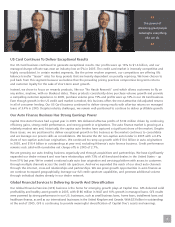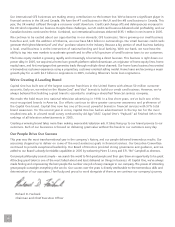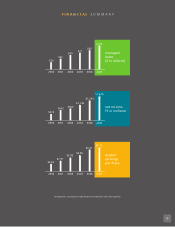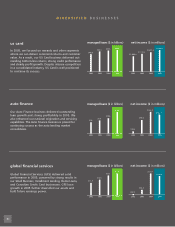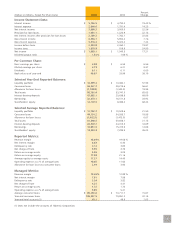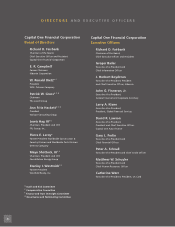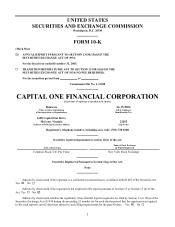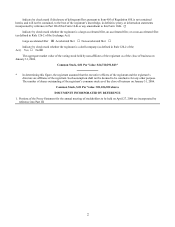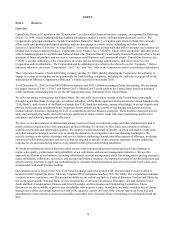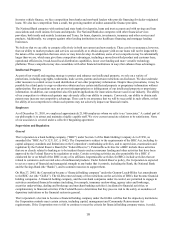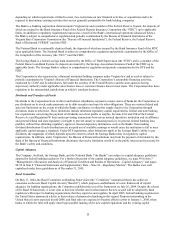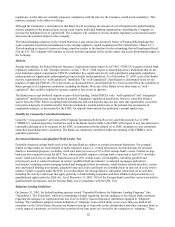Capital One 2005 Annual Report Download - page 14
Download and view the complete annual report
Please find page 14 of the 2005 Capital One annual report below. You can navigate through the pages in the report by either clicking on the pages listed below, or by using the keyword search tool below to find specific information within the annual report.B
usiness Description
Capital One is one of the world’ s largest financial services franchises. We are a diversified financial services corporation
focused primarily on consumer lending and deposits. Our principal business segments are domestic credit card lending,
automobile and other motor vehicle financing and global financial services. Beginning with the first quarter of 2006, we will
be reporting a banking segment. For further discussion of our segments, see pages 39-43 in Item 7 “Management’ s
Discussion and Analysis of Financial Condition and Results of Operations—Reportable Segment Summary” and pages 73-75
in Item 8 “Financial Statements and Supplementary Data—Notes to the Consolidated Financial Statements—Note 3”.
U.S. Card Segment. We offer a wide variety of credit card products throughout the United States. We customize our products
to appeal to different consumer preferences and needs by combining different product features, including annual percentage
rates, fees and credit limits, rewards programs and other special features. We routinely test new products to develop ones that
appeal to different and changing consumer preferences. Our customized products include both products offered to a wide
range of consumer credit risk profiles, as well as products aimed at special consumer interests. Our pricing strategies are risk-
based; lower risk customers may likely be offered products with more favorable pricing and we expect these products to yield
lower delinquencies and credit losses. On products offered to higher risk customers, however, we are likely to experience
higher delinquencies and losses, and we price these products accordingly.
Auto Finance Segment. Through COAF, we purchase retail installment contracts, secured by automobiles or other motor
vehicles, through dealer networks throughout the United States. Additionally, we utilize direct marketing to offer automobile
financing directly to consumers. Our direct marketed products include financing for the purchase of new and used vehicles,
as well as refinancing of existing motor vehicle loans. As of December 31, 2005, we are the second largest non-captive auto
lender in the United States. In January 2005, we acquired Onyx Acceptance Corporation, an auto finance company that
provides financing to franchised and select independent dealerships throughout the United States. The Corporation also
completed the acquisition of Key Bank’ s non-prime auto loan portfolio in 2005. Similar to our credit card strategy, we
customize product features, such as interest rate, loan amount, and loan terms, enabling us to lend to customers with a wide
range of credit profiles.
Global Financial Services Segment. Our Global Financial Services (“GFS”) segment includes a variety of diverse products
offered to consumers in the United States and internationally. Domestically, GFS includes small business lending, installment
lending, and healthcare financing. In addition, in early 2005, the Corporation acquired a mortgage lending business,
eSmartloan. We have, and may in the future achieve further diversification through acquisition, organic growth or both. GFS
also includes our international businesses, where we are using methodologies and approaches we have learned in our U.S.
credit card and other consumer lending businesses in new geographies. Internationally, we are currently operating primarily
in the United Kingdom and Canada. The Corporation completed its acquisition of Hfs Group, a home equity broker in the
United Kingdom, in January 2005.
cquisition of Hibernia Corporation A
On November 16, 2005, we completed our acquisition of Hibernia, a financial holding company that provides a wide array of
financial products and services through its bank and non-bank subsidiaries. Under the merger agreement, Hibernia merged
with and into the Corporation, and Capital One continued as the surviving corporation. We are focused on successfully
integrating Hibernia into the Corporation, and beginning with the first quarter of 2006, we will begin reporting on a new
Banking segment. The Banking segment will consist of Hibernia’ s former businesses, excluding Hibernia’ s indirect auto
usiness and including Capital One’ s existing branchless deposit business. b
G
eographic Diversity
Loan portfolio concentration within a specific geographic region may be regarded differently based upon the current and
expected credit characteristics and performance of the portfolio. Our loan portfolio is geographically diverse. See page 98 in
Item 8 “Financial Statements and Supplementary Data—Notes to the Consolidated Financial Statements—Note 23” of this
form.
Enterprise Risk Management
Risk is an inherent part of the Company’ s business and activities. The Company has an Enterprise Risk Management (ERM)
program designed to ensure appropriate and comprehensive oversight and management of risk. The ERM program has three
components. First, the Board of Directors and senior management committees oversee risk and risk management practices.
Second, the centralized departments headed by the Chief Enterprise Risk Officer and the Chief Credit Officer establish risk
management methodologies, processes and standards. Third, the individual business areas throughout the Company are
responsible for managing risk in their businesses and performing ongoing identification, assessment and response to risks.
5


